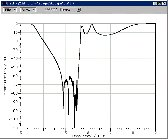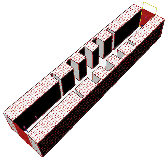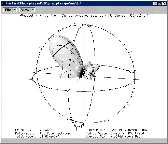THREE DIMENSIONAL EM SOFTWARE FOR PCs
Sonnet Software Inc.
Liverpool, NY
Commercial three-dimensional (3D) electromagnetic (EM) software has become a key to rapid prototyping and design of high frequency components, systems and antennas. However, these software packages have been practically limited to UNIX workstations or supercomputer environments because of their high processor and memory requirements. With the introduction of high performance, Pentium-class processors and modestly priced computer memory, desktop PCs now rival midclass workstations in performance, at a fraction of the cost.
Beginning with release 3.0, Micro-Stripes EM software takes advantage of the price/ performance of PCs with the introduction of a new PC version for Windows 95ª and Windows NT.ª Micro-Stripes 3.0 is also available for Sun Sparcstation and HP700 series UNIX workstations. Floating and node-locked licensing is available for both UNIX and PC networks.
3D EM Simulation in the Time Domain
Micro-Stripes is a high frequency EM simulator that employs the transmission line matrix (TLM), time-domain method to solve for the fields and currents of an arbitrary 3D structure. In Micro-Stripes, a device under test is excited with an initial impulse in a desired electric or magnetic field mode (at one or several ports), and the energy is allowed to scatter throughout the structure. Sense points throughout the structure gather field and current data, which are then postprocessed to obtain time-domain or frequency-domain information, S-parameters, surface currents and fields, and far-field radiation patterns. Micro-Stripes is applicable to the simulation of arbitrary antennas, waveguide filters, transitions, packages and resonators, and is useful for EM interference precompliance testing.
TLM offers significant advantages over conventional finite element method (FEM), frequency-domain analysis techniques. As a time-domain technique, Micro-Stripes provides wideband, high fidelity frequency-domain results from a single analysis through a simple Fourier transform. Typically, a single Micro-Stripes time-domain analysis yields hundreds to thousands of S-parameter or spectral data points - catching unexpected phenomena that might be missed in a frequency-domain analysis.
Computer memory requirements for the TLM method grow only linearly with respect to problem size, as compared to the exponential growth typical in FEM analyses. TLM is unconditionally stable, and simulation noise floors have been demonstrated that exceed 100 dB dynamic range. Because of these efficiency issues, Micro-Stripes is a practical solution for complex, full-3D EM analysis on PC platforms. 
Figure 1 shows an example of a waveguide filter simulated by Micro-Stripes. This result required 
Figure 2 shows an analysis of a seven-element phased helix array where the individual feeds are phased to simulate a beamsteered condition. Both 3D surface and two-dimensional (2D) far-field pattern cuts are shown. This analysis required




Figure 3 shows the application of Micro-Stripes to a high frequency alumina package with metallized walls. Two separate central chambers to house MMIC amplifiers are connected by microstrip through a wall; side chambers are included that might house DC bias and control circuitry.  Micro-Stripes determines the wideband package input/output isolation and shows the current density on the metallized surfaces at a frequency near a point of concern in the isolation (52 GHz). This package simulation required 32 MB of RAM - modest by today's PC platform standards.
Micro-Stripes determines the wideband package input/output isolation and shows the current density on the metallized surfaces at a frequency near a point of concern in the isolation (52 GHz). This package simulation required 32 MB of RAM - modest by today's PC platform standards.
New Features
With the introduction of Micro-Stripes release 3.0, several significant new features have been added to both the basic analysis package and the optional far-field pattern computation and visualization module. Support for network floating licensing is available for Micro-Stripes, and interface and solver licenses may be shared across PCs on a Windows 95 or Windows NT network. For multiple solver analyses, a new solver queue batch facility allows users to automatically run several analyses sequentially to maximize processor utilization.
Micro-Stripes model definitions have undergone some significant changes as well. New material types now may be defined to have anisotropic permittivity, permeability and conductivity. A new shape definition feature allows for structure hierarchies, which may be defined and referenced in higher level assemblies. Thin wire models with bends have been incorporated for model definition. Model simulation times have been shortened through the introduction of filtered input signals. Typically, time-domain simulations begin by stimulating the model at one or more ports with a field distribution corresponding to a desired mode. However, in general, an impulse signal has an infinite bandwidth, and frequencies that are beyond the model mesh capability are also stimulated, carrying energy that must be dissipated in the simulation. The new filtered input signal limits the bandwidth of the stimulating signal so that frequencies above the maximum frequency permitted by the mesh are never excited. This filtering results in shorter simulations and less computation overhead when space-domain results (fields and currents over regions) are requested.
Another model stimulation feature included with release 3.0 is multiple initial modes. With multiple initial modes, the model can be stimulated from any number of locations in the model. This capability is useful for simulating devices that incorporate phased signals, such as phased-array antennas with separately controlled element feeds. It is also used to simulate devices that generate circularly polarized fields. Each initial mode may be in phase, or arbitrary time delays may be specified for each port stimulation. Devices with high Q factors store EM fields at certain frequencies very well. When Micro-Stripes is used to simulate such devices, the time-domain response may decay slowly, making it necessary to calculate a large number of time steps. If the device is operating in the fundamental mode or a single higher order mode, the time-domain response is essentially a decaying sinusoid. Using a new response predictor module, a simulation will need to be run only until the device resonates. The response predictor uses linear prediction to extrapolate the response until it has decayed. This capability can provide large savings in computer run time. In some structures, it is necessary to compute S-parameters for diagonally or circularly polarized modes. For this purpose, a polarizer ratio module is introduced in release 3.0. This module is useful for the simulation of polarizer components where circularly polarized fields are fed to a device that provides one or both component linear polarizations as output. The polarizer ratio module accepts S-parameter results from two orthogonal linear-polarized waves as input and calculates return on the diagonal mode, coupling between the diagonal modes and left- and right-hand circular polarization modes, and axial ratio between the modes.
The far-field antenna pattern modules have been revisited to include 2D antenna pattern cuts for a variety of polarizations in addition to the standard 3D surface pattern plots. In addition, the capability has been added to feed antenna systems through either finite or infinite ground planes. A significant new feature in the UNIX version is EMCAD, a new ACIS solid modeler. EMCAD provides an advanced environment for building and meshing 3D model geometries, and imports models from pre-existing DXF, IGES and STEP modeling file formats. A PC release of EMCAD is expected later this year.
Conclusion
The PC is entering mainstream usefulness for computationally demanding algorithms, such as those used in EM analyses. Due to its low memory requirements, Micro-Stripes is a practical approach to the computation of full 3D structures on a PC. Micro-Stripes is available for Pentium PCs and UNIX workstations. PC requirements are 32 MB of RAM and 18 MB of hard disk space for program storage. No additional disk swap space is required, and most simulation projects require less than 1 MB of hard disk space for storage. Price: $25,000. Micro-Stripes is manufactured and sold by KCC Ltd., Nottingham, UK +44 (0) 115 925 5935, and is available in North America from Sonnet Software Inc. Additional information can be obtained from the Sonnet Software Web page located at http:// www.sonnetusa.com.
Sonnet Software Inc.
Liverpool, NY
(315) 453-3096
